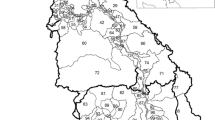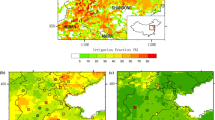Abstract
Water is one of the most critical resources in China. Climate change and soil degradation will be two major, interrelated environmental challenges faced by managers of water resources in coming decades. In this study, we used a water-balance model and updated databases to assess the interacting impacts of climate change and soil degradation on China’s future water resources. We plotted the spatial pattern of changes in actual and potential evapotranspiration, soil moisture deficits, and surface runoff across China in the 2020s using a resolution of 0.5° latitude and longitude under scenarios based on climate change, soil degradation, and a combination of the two. The results showed that climate change would affect the magnitude and spatial pattern of water resources on a national scale. Some regions in central, southwestern, and northeastern China would become more vulnerable to disastrous drought and floods as a result of soil degradation. Under the combined impacts of climate change and soil degradation, soil moisture deficits would increase most in central, western, and southwestern China; surface runoff would increase most in southeastern China. More detailed process-based models are needed to capture feedback mechanisms more effectively.
Similar content being viewed by others
References
Arnell, N. W.: 1999, ‘Climate change and global water resources’, Glob. Environ. Change 9, S51–S67.
Bryant, N. A., Johnson, L. F., Brazel, A. J., Balling, R. C., Hutchinson, C. F. and Beck,L. R.: 1990, ‘Measuring the effect of overgrazing in the Sonoran Desert’, Clim. Change 17, 243– 264.
Budyko, M. I.: 1956, Teplovoi Balans Zemnoi Poverkhnosti,Gidrometeorologicheskoe Izdatel’stvo, Leningrad, p. 255 [In Russian].
Chang, J.: 1970, ‘Global distribution of net radiation according to a new formula’, Ann. Assn. Am. Geogr. 60, 340–351.
Dunne, K. and Willmott, C. J.: 1996, ‘Global distribution of plant-extractable water capacity of soil’, Int. J. Clim. 16,841–859.
Evans, T. E.: 1996, ‘The effects of changes in the world hydrological cycleon the availability of water resources’, in Bazzaz, F. and Sombroek, W. (eds.), Global Climate Change and Agricultural Production, Wiley,Chichester, p. 248.
FAO: 1992, ‘Report on the expert consultation on revision of FAO methodologies for crop water requirements’, Land and Water Development Division, Food and Agriculture Organization, Rome.
Feddema, J. J.: 1999, ‘Future African water resources: interactions between soil degradation and global warming’, Clim. Change 42, 561–596.
Feng, Q., Cheng, G. and Mikami, M.: 2001, ‘The carbon cycle of sandy lands in China and its global significance’, Clim. Change 48, 535–549.
Fischer, G., van Velthuizen, H., Nachtergaele, F. and Medow, S.: 2000, ‘Global agro-ecological zone’, CD-ROM, FAO/IIASA, Rome.
IPCC: 1996, Climate Change 1995: in Houghton, J. T., Meira Filho, L. G., Callender,B. A., Harris, N.,Kattenberg, A. and Maskell, K. (eds.), The Science of Climate Change, Cambridge University Press, Cambridge, U.K., p. 572.
IPCC: 1998, in Watson, R. T.,Zinyowera, M. C. and Moss, R. H. (eds.), The Regional Impacts of Climate Change: An Assessment of Vulnerability. Special Report of IPCC WorkingGroup II, Cambridge University Press, Cambridge, U.K., p. 517.
IPCC: 2001, Climate Change 2001: in McCarthy, J. J., Canziani, O. F., Leary, N. A., Dokken,D. J. and White, K. S. (eds.), Impacts, Adaptation, and Vulnerability, Cambridge University Press, Cambridge, U.K., p. 551.
Legates, D. R.: 1995, ‘Global and terrestrial precipitation: a comparative assessment of existing climatologies’, Int. J. Clim. 15, 237–258.
Legates, D. R. and Mather, J. R.: 1992, ‘An evaluation of the average annual global water-balance’, Geogr. Rev. 82(3), 253–267.
Legates, D. R. and Willmott, C. J.: 1990a, ‘Mean seasonal and spatial variability in gauge-corrected global precipitation’, Int. J. Clim. 10, 111–127.
Legates, D. R. and Willmott, C. J.: 1990b, ‘Mean seasonal and spatial variability in global surface air temperature’ Theor. Appl. Climatol. 41, 11–21.
Lynden, G. W. J. and Oldeman, L. R.: 1997, The Assessment of the Status of Human-induced Soil Degradation in South and Southeast Asia, United Nations Environment Program (UNEP), Food and Agricultural Organization of the United Nations (FAO), International Soil Reference and Information Centre (ISRIC), Wageningen, The Netherlands.
Mabbutt, J. A.: 1989, ‘Impacts of carbon dioxide warming on climate and manin the semi-arid tropics’, Clim-Change 15, 191–221.
Middleton, N. J. and Thomas, D. S. G.: 1992, World Atlas of Desertification, UnitedNations Environment Programme, Geneva, p. 90.
New, M., Hulme, M. and Jones, P.: 1999, ‘Representing twentieth-century space–time climate variability. Part I: Development of a 1961–90 mean monthly terrestrial climatology’, J. Clim. 12, 829–856.
Nicholson, S. E.: 1989, ‘Land surface atmosphere interaction: Physical processes and surface changes and their impacts’, Prog. Phys. Geog. 12, 36–65.
Oldeman, L. R. (ed.): 1988, Guidelines for General Assessment of the Status of Human-Induced Soil Degradation, International Soil Reference and Information Centre (ISRIC), Working Paper and Preprint 88/4.
Oldeman, L. R., Hakkeling, R. T. A. and Sombroek, W. G.: 1991, World Map of the Status of Human-induced Soil Degradation: An Explanatory Note,second revised edition, International Soil Reference and Information Centre (ISRIC)/United Nations Environment Programme (UNEP).
Oropeza-Mota, J. L., Rios-Berber, J. D. and Huerta-Martinez, E.: 1995, ‘Water erosion evaluation of tepetates in relation to reclamation and productivity’, J. Soil Water Conserv. 50, 523–526.
Penman, H. E.: 1948, ‘Natural evaporation from open water, bare soil, and grass’, Proc. R. Soc. Lond. Ser. A. 194, 120–145.
Pierce, F. J. and Lal, R.: 1994, ‘Monitoring soil erosion’s impacts on cropproductivity’, in Lal, R. (ed.), Soil Erosion Research Methods, Soil and Water Conservation Society of America, Ankeny, IA, pp. 235–264.
Qian, W. and Zhu, Y.: 2001, ‘Climate change in china from 1880 to 1998 and its impact on the environmental condition’, Clim. Change 50, 419–444.
Tao, F., Yokozawa, M., Hayashi, Y. and Lin, E.: 2003a, ‘Terrestrial water cycle and the impact of climate change’, Ambio 32(4), 295–301.
Tao, F., Yokozawa, M., Hayashi, Y. and Lin, E.: 2003b, ‘Changes in agricultural water demands and soil moisture in china over the last half-century and their effects on agricultural production’, Agric. For. Meteorol. 118, 251–261.
Thornthwaite, C. W.: 1948, ‘An approach toward a rational classification ofclimate’, Geog. Rev. 38(1), 55–94.
Varies, O. and Vakkilainen, P.: 2001, ‘China’s 8 challenges to water resources management in the first quarter of the 21st century’, Geomorphology 41(2/3), 93–104.
Williams, J. R., Allmaras, R. R., Renard, K. G., Lyles, L., Moldenhauer, W.D., Langdate, G. W., Meyer, L. D. and Rawls, W. J.: 1981, ‘Soil erosion effects on soil productivity: A research perspective’, J. Soil Water Conserv. 36(2), 82–90.
Williams, M. A. J. and Balling, R. C.: 1996, Interaction of Desertification and Climate, For World Meteorological Organization (WMO)/United Nations Environment Programme (UNEP), Arnold Press, London, p.270.
Willmott, C. J., Rowe, C. N. and Mintze, Y.: 1985, ‘Climatology of the terrestrial seasonal water cycle’, J. Climatol. 5, 589–606.
Author information
Authors and Affiliations
Corresponding author
Rights and permissions
About this article
Cite this article
Tao, F., Yokozawa, M., Hayashi, Y. et al. A Perspective on Water Resources in China: Interactions between Climate Change and Soil Degradation. Climatic Change 68, 169–197 (2005). https://doi.org/10.1007/s10584-005-6013-1
Received:
Revised:
Issue Date:
DOI: https://doi.org/10.1007/s10584-005-6013-1




